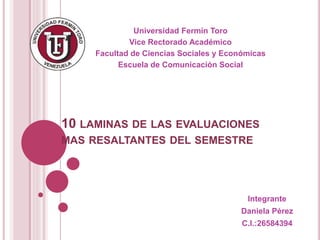
10 hojas de evaluaciones más destacadas del semestre
- 1. 10 LAMINAS DE LAS EVALUACIONES MAS RESALTANTES DEL SEMESTRE Universidad Fermín Toro Vice Rectorado Académico Facultad de Ciencias Sociales y Económicas Escuela de Comunicación Social Integrante Daniela Pérez C.I.:26584394
- 2. Skimming ¿Para qué se utiliza? ¿Cómo se utiliza este tipo de lectura? How to Skim: * Read the title. * Read the introduction or the first paragraph. * Read the first sentence of every other paragraph. * Read any headings and sub-headings. * Notice any pictures, charts, or graphs. * Notice any italicized or boldface words or phrases. * Read the summary or last paragraph. Involves the search for the main ideas by reading the first and last paragraphs, taking into account other signals of organization such as abstracts, used by the author It is used to quickly identify the main ideas of a text. When you read the newspaper, you're probably not reading word for word, instead of scanning the text Is used to locate the general sense of the reading or a certain part of it. This technique will now give you a lot of time and gives you a very general idea of what the text or paragraph is about.
- 3. is a reading technique to be used when you want to find specific information quickly. In scanning you have a question in your mind and you read a passage only to find the answer, ignoring unrelated information Scanning * State the specific information you are looking for. * Try to anticipate how the answer will appear and what clues you might use to help you locate the answer. For example, if you were looking for a certain date, you would quickly read the paragraph looking only for numbers. * Use headings and any other aids that will help you identify which sections might contain the information you are looking for * Selectively read and skip through sections of the passage.
- 4. To BE + (verb+ing) Subjeto + el verbo to be en forma negativa + present participle (verbo + ing) Ejemplo: I'm not reading. NEGATIVAS AUXILIAR to have” have has Verbo auxiliar (to have) + sujeto + participio pasado…? Ejemplo: Have you been to London? INTERROGATIVAS Sujeto + verbo auxiliar (to have) + participio pasado… Ejemplo: I have [I’ve] talked to Peter. Sujeto + verbo auxiliar (to have) + “not” + participio pasado… Ejemplo: They haven’t learned English Se utiliza para hablar acerca de hechos o verdades generales que constituyen hábitos, horarios o programas, costumbres y rutinas de la vida cotidiana. Indica la acción que está ocurriendo en el momento en que se está hablando, en proceso de llevar acabo. Indica la acción que está ocurriendo en el momento en que se está hablando, en proceso de llevar acabo.
- 5. AUXILIAR: “to have” had, has La mención del pasado refiere a acciones que ya se realizaron con anterioridad (es decir, que ya fueron concretadas). AUXILIAR: Went, bought. Terminación ed y d. Did y didn't INTEROGATIVA: Auxiliar did al principio de la oración + el sujeto + el verbo en infinitivo + el complemento. EJEMPLO: I didn't go to Salamanca last month. (No fui a Salamanca el mes pasado. AUXILIAR: (was y were) Terminación en ing El pasado continuo o pasado progresivo (past continuous tense) se forma escribiendo el verbo to be que corresponde a cada sujeto en pasado simple. Corresponde al pluscuamperfecto de español. En general, lo usamos para acciones que han ocurrido antes de otra acción en el pasado. AFIRMATIVA Pronombre o sujeto+ verbo con terminación en “D” o “ed” + complemento. EJ: I played: yo jugaré. AFIRMATIVA: Sujeto + “had” + participio pasado… Ejemplo: They had [They’d] studied English before they went to London. INTERRIGATIVA: Verbo auxiliar (to be) + sujeto + gerundio? Ejempolo: Were you talking?: AFIRMATIVA: Sujeto + verbo auxiliar (to be) + gerundio. Ejemplo: I was talking. NEGATIVA: auxiliar en pasado más not (did not o didn't + el verbo en infinitivo): EJ: I didn't go to Salamanca last month. (No fui a Salamanca el mes pasado NEGATIVA: Sujeto + “had” + “not” + participio pasado… Ejemplo: They had not [hadn’t] studied English before they went to London. NEGATIVA: Sujeto + verbo auxiliar (to be) + “not” + gerundio. Pejemplo: I was not [wasn’t] talking. INTERRIGATIVA: “Had” + sujeto + participio pasado…? Ejemplo: Had they studied English before they went to London?
- 6. Hay dos formas principales para expresar el futuro. A veces son intercambiables, pero a menudo pueden tener significados diferentes. INTERROGATIVASA: “Will” + sujeto + verbo principal. Ejemplo: Ejemplo: Will you call me tonight? AFORMATIVA: Sujeto + “will” + verbo principal. ejemplo: She will [She’ll] arrive late NEGATUVAS Sujeto + “will” + “not” + verbo principal: Ejemplo: I will not [won’t] call you tonight. Es un tiempo que usamos en inglés para hablar del futuro y se traduce por "ir a (hacer algo)". AYXILIAR: “to be” (conjugado) is, am INTERROGATIVA: sujeto y el auxiliar "to be" en las preguntas Ejemplo: Is he going to jog? AFIRMATIVA: sujeto + verbo to be (conjugado en presente) + going to + verbo. Ejemplo: He is going to jog NEGATIVA: SUJETO + am/are/is not going to + VERBO EN INFINITIVO Ejemplo: He is not going to jog.